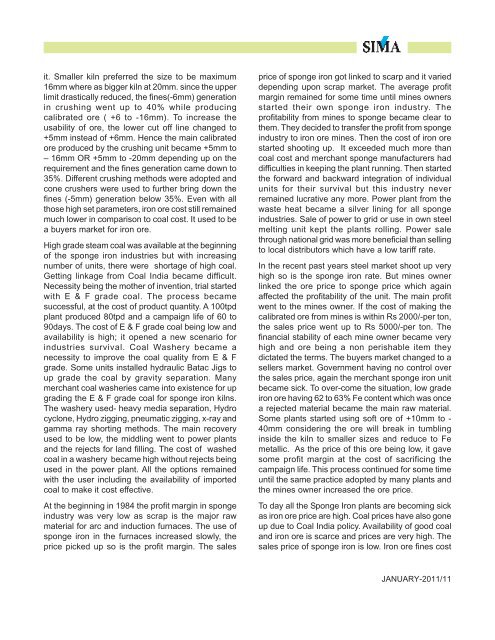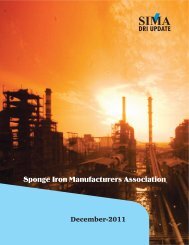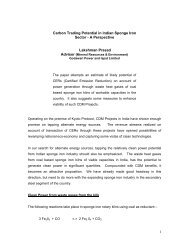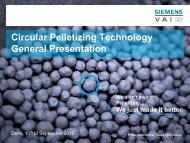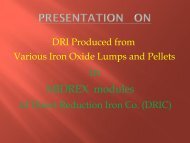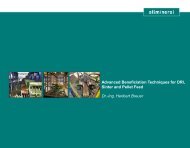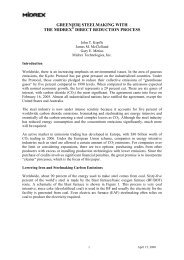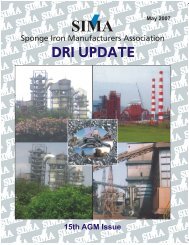sponge iron industry –past-present-future - SIMA
sponge iron industry –past-present-future - SIMA
sponge iron industry –past-present-future - SIMA
Create successful ePaper yourself
Turn your PDF publications into a flip-book with our unique Google optimized e-Paper software.
it. Smaller kiln preferred the size to be maximum<br />
16mm where as bigger kiln at 20mm. since the upper<br />
limit drastically reduced, the fines(-6mm) generation<br />
in crushing went up to 40% while producing<br />
calibrated ore ( +6 to -16mm). To increase the<br />
usability of ore, the lower cut off line changed to<br />
+5mm instead of +6mm. Hence the main calibrated<br />
ore produced by the crushing unit became +5mm to<br />
– 16mm OR +5mm to -20mm depending up on the<br />
requirement and the fines generation came down to<br />
35%. Different crushing methods were adopted and<br />
cone crushers were used to further bring down the<br />
fines (-5mm) generation below 35%. Even with all<br />
those high set parameters, <strong>iron</strong> ore cost still remained<br />
much lower in comparison to coal cost. It used to be<br />
a buyers market for <strong>iron</strong> ore.<br />
High grade steam coal was available at the beginning<br />
of the <strong>sponge</strong> <strong>iron</strong> industries but with increasing<br />
number of units, there were shortage of high coal.<br />
Getting linkage from Coal India became difficult.<br />
Necessity being the mother of invention, trial started<br />
with E & F grade coal. The process became<br />
successful, at the cost of product quantity. A 100tpd<br />
plant produced 80tpd and a campaign life of 60 to<br />
90days. The cost of E & F grade coal being low and<br />
availability is high; it opened a new scenario for<br />
industries survival. Coal Washery became a<br />
necessity to improve the coal quality from E & F<br />
grade. Some units installed hydraulic Batac Jigs to<br />
up grade the coal by gravity separation. Many<br />
merchant coal washeries came into existence for up<br />
grading the E & F grade coal for <strong>sponge</strong> <strong>iron</strong> kilns.<br />
The washery used- heavy media separation, Hydro<br />
cyclone, Hydro zigging, pneumatic zigging, x-ray and<br />
gamma ray shorting methods. The main recovery<br />
used to be low, the middling went to power plants<br />
and the rejects for land filling. The cost of washed<br />
coal in a washery became high without rejects being<br />
used in the power plant. All the options remained<br />
with the user including the availability of imported<br />
coal to make it cost effective.<br />
At the beginning in 1984 the profit margin in <strong>sponge</strong><br />
<strong>industry</strong> was very low as scrap is the major raw<br />
material for arc and induction furnaces. The use of<br />
<strong>sponge</strong> <strong>iron</strong> in the furnaces increased slowly, the<br />
price picked up so is the profit margin. The sales<br />
price of <strong>sponge</strong> <strong>iron</strong> got linked to scarp and it varied<br />
depending upon scrap market. The average profit<br />
margin remained for some time until mines owners<br />
started their own <strong>sponge</strong> <strong>iron</strong> <strong>industry</strong>. The<br />
profitability from mines to <strong>sponge</strong> became clear to<br />
them. They decided to transfer the profit from <strong>sponge</strong><br />
<strong>industry</strong> to <strong>iron</strong> ore mines. Then the cost of <strong>iron</strong> ore<br />
started shooting up. It exceeded much more than<br />
coal cost and merchant <strong>sponge</strong> manufacturers had<br />
difficulties in keeping the plant running. Then started<br />
the forward and backward integration of individual<br />
units for their survival but this <strong>industry</strong> never<br />
remained lucrative any more. Power plant from the<br />
waste heat became a silver lining for all <strong>sponge</strong><br />
industries. Sale of power to grid or use in own steel<br />
melting unit kept the plants rolling. Power sale<br />
through national grid was more beneficial than selling<br />
to local distributors which have a low tariff rate.<br />
In the recent past years steel market shoot up very<br />
high so is the <strong>sponge</strong> <strong>iron</strong> rate. But mines owner<br />
linked the ore price to <strong>sponge</strong> price which again<br />
affected the profitability of the unit. The main profit<br />
went to the mines owner. If the cost of making the<br />
calibrated ore from mines is within Rs 2000/-per ton,<br />
the sales price went up to Rs 5000/-per ton. The<br />
financial stability of each mine owner became very<br />
high and ore being a non perishable item they<br />
dictated the terms. The buyers market changed to a<br />
sellers market. Government having no control over<br />
the sales price, again the merchant <strong>sponge</strong> <strong>iron</strong> unit<br />
became sick. To over-come the situation, low grade<br />
<strong>iron</strong> ore having 62 to 63% Fe content which was once<br />
a rejected material became the main raw material.<br />
Some plants started using soft ore of +10mm to -<br />
40mm considering the ore will break in tumbling<br />
inside the kiln to smaller sizes and reduce to Fe<br />
metallic. As the price of this ore being low, it gave<br />
some profit margin at the cost of sacrificing the<br />
campaign life. This process continued for some time<br />
until the same practice adopted by many plants and<br />
the mines owner increased the ore price.<br />
To day all the Sponge Iron plants are becoming sick<br />
as <strong>iron</strong> ore price are high. Coal prices have also gone<br />
up due to Coal India policy. Availability of good coal<br />
and <strong>iron</strong> ore is scarce and prices are very high. The<br />
sales price of <strong>sponge</strong> <strong>iron</strong> is low. Iron ore fines cost<br />
JANUARY-2011/11


